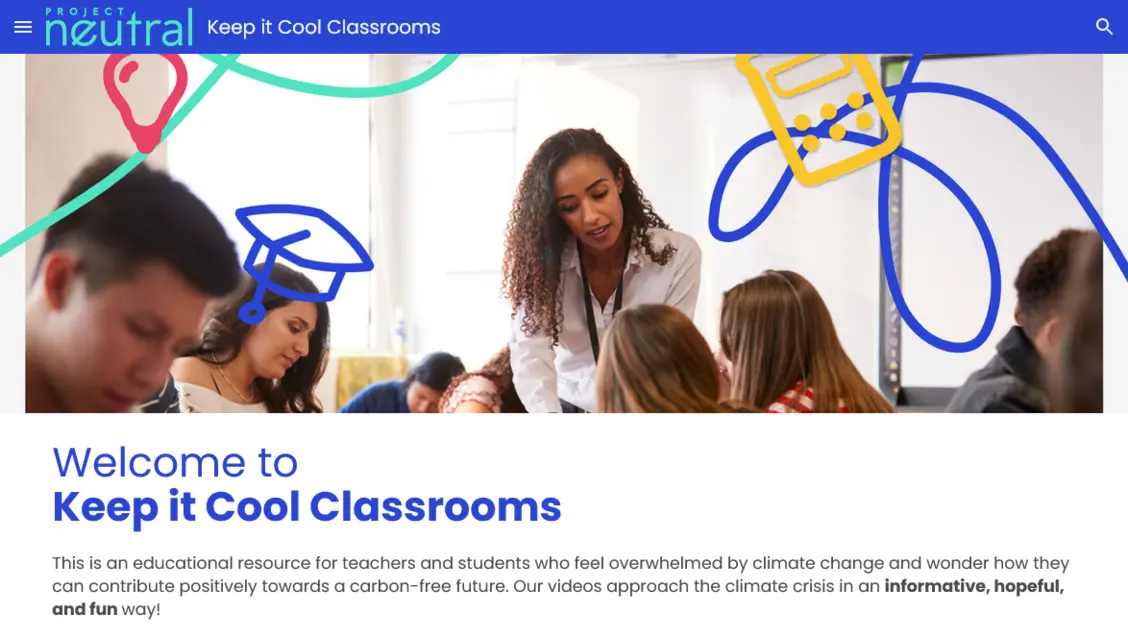When we teach climate change from a global perspective, it can be vast and intimidating. We want students to realize that climate change is something they can tackle individually, as a community, and as a generation.
Enter Keep it Cool Classrooms, through group sessions featuring Project Neutral’s free, easy-to-use carbon footprint calculator, students will understand their carbon footprints, build climate literacy, and start to take meaningful climate action.
Keep it Cool Classrooms
We've developed a full climate change lesson that can be delivered easily and on demand.
It works perfectly as a classroom experience, homework assignment or Eco Team activity!
Materials: Screen for viewing and internet connected devices for measuring carbon footprints
Estimated Time: 60 minutes of videos, 1.5 hours with discussion time
Grade Level: 7 to 12
Visit our standalone Keep it Cool Classroom site for a Teacher Guide, Student handout and additional resources.
Ontario Curriculum Connections
There are several direct learning objectives in Ontario’s curriculum which cover the topics of understanding carbon footprints and there are numerous opportunities for teachers to incorporate climate change into their teaching.
Grade 10 Applied Science
D2.5 investigate their personal carbon footprint, using a computer simulation or numerical data (e.g., determine carbon emissions that result from their travelling to school, work, and recreation venues - from vacation travelling to buying products imported from distant countries) - and plan a course of action to reduce their footprint (e.g., a plan to increase their use of bicycles or public transit; to eat more local foods) [PR, AI, C]
Grade 11 University Preparation Science
F1.1 analyse the effects on air quality of some technologies and human activities (e.g., smelting; driving gas-powered vehicles), including their own activities, and propose actions to reduce their personal carbon footprint [AI, C]
Grade 11 Environmental Science
B3.4 explain the concept of a “carbon footprint” and how it is used to measure the impact on the environment of a range of human activities
Grade 11 Environmental Science
B3.4 explain the concept of a “carbon footprint” and how it is used to measure the impact on the environment of a range of human activities
Grade 9 Academic Geography
E1.3 analyse the effects of individual lifestyle choices on energy consumption and production, and assess the implications for sustainability in Canada
Grade 9 Academic Geography
E1.3 analyse the effects of individual lifestyle choices on energy consumption and production, and assess the implications for sustainability in Canada
Grade 9 Applied Geography
E1.1 use a variety of measurements (e.g., ecological footprint, carbon footprint, water footprint) to compare the impact on the natural environment of people in Canada and people in other countries
Grade 7 Understanding Earth And Space Systems - Heat In The Environment
3.8 identify common sources of greenhouse gases (e.g., carbon dioxide comes from plant and animal respiration and the burning of fossil fuels; methane comes from wetlands, grazing livestock, termites, fossil fuel extraction, and landfills; nitrous oxide comes from soils and nitrogen fertilizers), and describe ways of reducing emissions of these gases
Bringing Keep it Cool Classrooms to students will create enriching learning opportunities to nurture student interest in climate issues and support the next generation of action takers in our community!
We recognize that ensuring the privacy of students must be paramount for this project to be successful. It is not our intention to collect student email addresses or to have students create accounts with us directly. Only parents/guardians/teachers will be associated with Project Neutral accounts.


